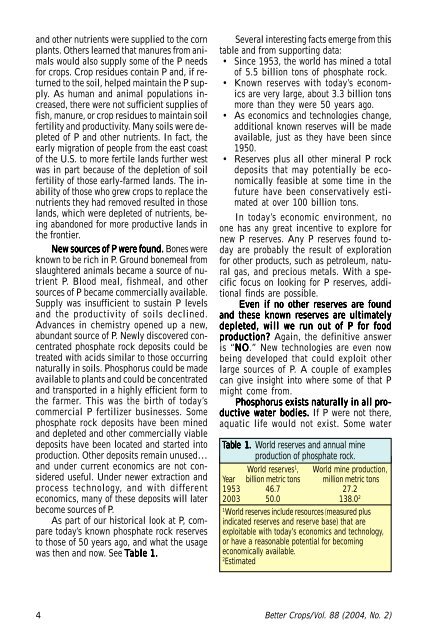Better Crops 2004 #2 - International Plant Nutrition Institute
Better Crops 2004 #2 - International Plant Nutrition Institute
Better Crops 2004 #2 - International Plant Nutrition Institute
You also want an ePaper? Increase the reach of your titles
YUMPU automatically turns print PDFs into web optimized ePapers that Google loves.
and other nutrients were supplied to the corn<br />
plants. Others learned that manures from animals<br />
would also supply some of the P needs<br />
for crops. Crop residues contain P and, if returned<br />
to the soil, helped maintain the P supply.<br />
As human and animal populations increased,<br />
there were not sufficient supplies of<br />
fish, manure, or crop residues to maintain soil<br />
fertility and productivity. Many soils were depleted<br />
of P and other nutrients. In fact, the<br />
early migration of people from the east coast<br />
of the U.S. to more fertile lands further west<br />
was in part because of the depletion of soil<br />
fertility of those early-farmed lands. The inability<br />
of those who grew crops to replace the<br />
nutrients they had removed resulted in those<br />
lands, which were depleted of nutrients, being<br />
abandoned for more productive lands in<br />
the frontier.<br />
New sources of P were found. Bones were<br />
known to be rich in P. Ground bonemeal from<br />
slaughtered animals became a source of nutrient<br />
P. Blood meal, fishmeal, and other<br />
sources of P became commercially available.<br />
Supply was insufficient to sustain P levels<br />
and the productivity of soils declined.<br />
Advances in chemistry opened up a new,<br />
abundant source of P. Newly discovered concentrated<br />
phosphate rock deposits could be<br />
treated with acids similar to those occurring<br />
naturally in soils. Phosphorus could be made<br />
available to plants and could be concentrated<br />
and transported in a highly efficient form to<br />
the farmer. This was the birth of today’s<br />
commercial P fertilizer businesses. Some<br />
phosphate rock deposits have been mined<br />
and depleted and other commercially viable<br />
deposits have been located and started into<br />
production. Other deposits remain unused…<br />
and under current economics are not considered<br />
useful. Under newer extraction and<br />
process technology, and with different<br />
economics, many of these deposits will later<br />
become sources of P.<br />
As part of our historical look at P, compare<br />
today’s known phosphate rock reserves<br />
to those of 50 years ago, and what the usage<br />
was then and now. See Table 1.<br />
Several interesting facts emerge from this<br />
table and from supporting data:<br />
• Since 1953, the world has mined a total<br />
of 5.5 billion tons of phosphate rock.<br />
• Known reserves with today’s economics<br />
are very large, about 3.3 billion tons<br />
more than they were 50 years ago.<br />
• As economics and technologies change,<br />
additional known reserves will be made<br />
available, just as they have been since<br />
1950.<br />
• Reserves plus all other mineral P rock<br />
deposits that may potentially be economically<br />
feasible at some time in the<br />
future have been conservatively estimated<br />
at over 100 billion tons.<br />
In today’s economic environment, no<br />
one has any great incentive to explore for<br />
new P reserves. Any P reserves found today<br />
are probably the result of exploration<br />
for other products, such as petroleum, natural<br />
gas, and precious metals. With a specific<br />
focus on looking for P reserves, additional<br />
finds are possible.<br />
Even if no other reser<br />
eserves ves are e found<br />
and these known reser<br />
eserves ves are e ultimately<br />
depleted, will we run out of P for food<br />
production?<br />
Again, the definitive answer<br />
is “NO<br />
NO.” New technologies are even now<br />
being developed that could exploit other<br />
large sources of P. A couple of examples<br />
can give insight into where some of that P<br />
might come from.<br />
Phosphorus exists naturally in all pro-<br />
ductive water bodies. If P were not there,<br />
aquatic life would not exist. Some water<br />
Table 1. World reserves and annual mine<br />
production of phosphate rock.<br />
World reserves 1 , World mine production,<br />
Year billion metric tons million metric tons<br />
1953 46.7 27.2<br />
2003 50.0 138.0 2<br />
1<br />
World reserves include resources (measured plus<br />
indicated reserves and reserve base) that are<br />
exploitable with today’s economics and technology,<br />
or have a reasonable potential for becoming<br />
economically available.<br />
2<br />
Estimated<br />
4 <strong>Better</strong> <strong>Crops</strong>/Vol. 88 (<strong>2004</strong>, No. 2)

















